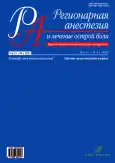Optimization of anesthesiological support with the use of regional anesthesia in pediatric endorinolaryngology
- Authors: Korobova L.S.1, Matinyan N.V.1,2, Lazarev V.V.2, Tsintsadze A.A.1, Merkulov O.A.1, Korolev V.A.1
-
Affiliations:
- National medical research center of Oncology. N.N. Blokhin
- Russian national research medical University. N.I. Pirogov» of the Ministry of health of Russia
- Issue: Vol 15, No 4 (2021)
- Pages: 287-296
- Section: Original articles
- URL: https://journal-vniispk.ru/1993-6508/article/view/108264
- DOI: https://doi.org/10.17816/1993-6508-2021-15-4-287-296
- ID: 108264
Cite item
Abstract
BACKGROUND: According to world statistics, about 1–5% of all malignant tumors are localized in the nasal cavity and rhinopharynx. Endoscopic rhinolaryngosurgery is considered to be low-traumatic. Combining general anesthesia with regional anesthesia improves the quality of the operation and ensures the effectiveness and safety of surgical intervention. To optimize the anesthetic support for endoscopic pediatric rhinolaryngology, we proposed a method of combining bilateral cranial anesthesia with palatal access (or palatine) to guarantee perioperative analgesia and provide comfortable conditions for the surgeon (minimize bleeding). Comfortable conditions also imply a reduction in the intensity of postoperative pain. Pain syndrome after surgery is also associated with the use of a Merocel nasal tampon, which also results in reflexogenic reactions. Therefore, we proposed to perform infiltration anesthesia of the nose from three points according to Weissblatt immediately after surgery to reduce the manifestations of discomfort, pain syndrome, and reflex reactions from standing with a Merocel nasal tampon.
AIM: This study aimed to optimize the anesthetic provision with the use of regional anesthesia in pediatric endorinolaryngology.
MATERIALS AND METHODS: At the end of July 2021, two endoscopic rhinosinusosurgical interventions were performed at the N.N. Blokhin Research Institute of DO and G, which were of interest for the development of optimized anesthesia approach. Two patients of comparable age were treated in the 1st surgical department and underwent combined anesthesia with the use of wing anesthesia with palatal access. For postoperative anesthesia, one patient underwent infiltration anesthesia of the nose from three points according to Weissblatt, and the other underwent infraorbital anesthesia.
RESULTS: In both subjects, combined anesthesia with the use of regional anesthesia methods provided sufficient efficacy and safety; ensured the comfort of the surgeon’s work; and reduced the risk of trigeminocardial reflex, postoperative nausea, and vomiting and the concentrations of inhalation anesthetics to be applied. Therefore, the use of infiltration anesthesia of the nose from three points according to Weissblatt significantly improves the quality of life in the postoperative period and eases the discomfort from the Merocel nasal tampon.
CONCLUSIONS: The results elucidated the combination of preventive analgesia and multimodal anesthesia.
Full Text
##article.viewOnOriginalSite##About the authors
Lyudmila S. Korobova
National medical research center of Oncology. N.N. Blokhin
Author for correspondence.
Email: Lydmil@bk.ru
ORCID iD: 0000-0003-3047-412X
SPIN-code: 6197-8273
Scopus Author ID: 104975
MD, Cand. Sci. (Med.)
Russian Federation, 24, Kashirskoye highway, Moscow, 115478Nune V. Matinyan
National medical research center of Oncology. N.N. Blokhin; Russian national research medical University. N.I. Pirogov» of the Ministry of health of Russia
Email: n9031990633@yandex.ru
ORCID iD: 0000-0001-7805-5616
SPIN-code: 9829-6657
MD, Dr. Sci. (Med.), Professor
Russian Federation, Moscow; MoscowVladimir V. Lazarev
Russian national research medical University. N.I. Pirogov» of the Ministry of health of Russia
Email: lazarev_vv@inbox.ru
ORCID iD: 0000-0001-8417-3555
SPIN-code: 4414-0677
ResearcherId: P-6234-2015
MD, Dr. Sci. (Med.), Professor
MoscowAnastasia A. Tsintsadze
National medical research center of Oncology. N.N. Blokhin
Email: anestesia228@mail.ru
ORCID iD: 0000-0003-1897-0331
SPIN-code: 6513-9338
Scopus Author ID: 1144875
MD, Cand. Sci. (Med.)
Russian Federation, MoscowOleg A. Merkulov
National medical research center of Oncology. N.N. Blokhin
Email: 9166718244@mail.ru
ORCID iD: 0000-0002-8533-0724
SPIN-code: 1492-1083
Scopus Author ID: 382666;
MD, Dr. Sci. (Med.)
Russian Federation, MoscowVladimir A. Korolev
National medical research center of Oncology. N.N. Blokhin
Email: korolev4@yandex.ru
ORCID iD: 0000-0003-1079-7589
MD, Cand. Sci. (Med.)
Russian Federation, MoscowReferences
- Vigand ME, Iro Kh. Endoskopicheskaya khirurgiya okolonosovykh pazukh i perednego otdela osnovaniya cherepa. Moscow: Meditsinskaya literatura; 2014. (In Russ).
- Martynov LA, Sotnikov AV, Merkulov OA, et al. Anesthetic Management of Endoscopic Endonasal Surgeries in Pediatric Oncology. Oncopediatrics. 2017;4(3):204–213. (In Russ). doi: 10.15690/onco.v4i3.1752
- Singh G, Chowdhury T. Brain and heart connections: The trigeminocardiac reflex! Journal of Neuroanaesthesiology and Critical Care. 2018;04(02):071–077. doi: 10.4103/jnacc-jnacc-24.17
- Sharma SB, Janakiram TN, Baxi H, Chinnasamy B. Trigeminocardiac reflex during endoscopic juvenile nasopharyngeal angiofibroma surgery: an appraisal. Eur Arch Otorhinolaryngol. 2017;274(7):2779–2784. doi: 10.1007/s00405-017-4521-z
- Ovchar TA, Lazarev VV. Anesthetic management of functional endoscopic endonasal rhinosinus surgery in children. Anesteziologiya i Reanimatologiya. 2020(1):55. doi: 10.17116/anaesthesiology202001155
- Borodulin VG, Filimonov SV. The blockade of sphenopalatineganglionthrough the palatal approachin the present-day rhinological practice. Vestnik otorinolaringologii. 2016;81(4):38. doi: 10.17116/otorino201681438-41
- Kiselev AS. K istorii otkrytiya Ganglion septi nasi i ego znachenie dlya klinicheskoi rinologii. Russian journal of pain. 1996;(5):35–37. (In Russ).
- Kastyro IV, Demina EN, Gulinov KA. Bolevoi sindrom i vegetativnyi otvet posle septoplastiki kostnogo otdela peregorodki nosa. Russian journal of pain. 2014;(1):36. (In Russ).
- Kastyro I.V. ST-segment and rhinocardiac reflex after septoplasty. Rossiiskaya otorinolaringologiya. 2014;(1):83–85.
- Tunyan NT. Refleksogennye zony LOR-organov. Saint Petersburg; 2005. 10 p.
- Baxandall ML, Thorn JL. The nasocardiac reflex. Anaesthesia. 1988;43(6):480–481. doi: 10.1111/j.1365-2044.1988.tb06637.x
- Haldar R, Kaur J, Bajwa SJ. Nasocardiac reflex during aspiration and injection through a nasogastric tube: An infrequent occurrence. Indian J Crit Care Med. 2015;19(4):237–239. doi: 10.4103/0972-5229.154574
- Kaufman J, Wright GW. The effect of nasal and nasopharyngeal irritation on airway resistance in man. Am Rev Respir Dis. 1969;100(5):626–630. doi: 10.1164/arrd.1969.100.5.626
- Undem BJ, McAlexander M, Hunter DD. Neurobiology of the upper and lower airways. Allergy. 1999;54(57):81–93. doi: 10.1111/j.1398-9995.1999.tb04409.x
- Kesimci E, Ozturk L, Bercin S, et al. Role of sphenopalatine ganglion block for postoperative analgesia after functional endoscopic sinus surgery. Eur Arch Otorhinolaryngol. 2012;269(1):165–169. doi: 10.1007/s00405-011-1702-z
- Borodulin VG. Primenenie blokady krylonebnogo gangliya v khirurgicheskom lechenii patologii polosti nosa [dissertation]. Saint Petersburg; 2015.
- Vigand ME, Iro Kh. Endoskopicheskaya khirurgiya okolonosovykh pazukh i perednego otdela osnovaniya cherepa. Moscow: Meditsinskaya literatura; 2014. 296 p.
- Vaisblat SN. Mestnoe obezbolivanie pri operatsiyakh na litse, chelyustyakh i zubakh. Moscow: Kniga po Trebovaniyu; 2013. 470 p.
Supplementary files














